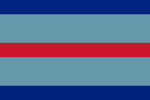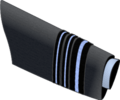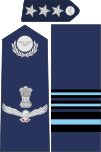Air marshal
Air marshal (Air Mshl or AM) is a three-star[1] air-officer rank which originated and it is used by the Royal Air Force.[2] The rank is also used by the air forces of many countries which have historical British influence, including the Commonwealth, and it is sometimes used as the English translation of an equivalent rank in countries which have a non-English air force-specific rank structure.
| Air marshal | |
|---|---|
 An RAF air marshal's command flag | |
 Shoulder and sleeve insignia from the Royal Air Force | |
 A RAF Air Marshal star plate | |
| Service branch | Air forces |
| Abbreviation | Air Mshl / AM |
| Rank | Three-star |
| NATO rank | OF-8 |
| Non-NATO rank | O-8 |
| Formation | 1 August 1919 (RAF) |
| Next higher rank | Air chief marshal |
| Next lower rank | Air vice-marshal |
| Equivalent ranks | |
Air marshal is a three-star rank and has a NATO ranking code of OF-8, equivalent to a vice-admiral in the Royal Navy or a lieutenant-general in the British Army or the Royal Marines. In other NATO forces, such as the United States Armed Forces and the Canadian Armed Forces, the equivalent three-star rank is lieutenant general.
The rank of air marshal is immediately senior to the rank of air vice-marshal and immediately subordinate to the rank of air chief marshal.
Officers in the rank of air marshal typically hold very senior appointments such as commander-in-chief of an air force or a large air force formation. Officers in the ranks of air chief marshal and air vice-marshal are also referred to generically as air marshals.[3] Occasionally, air force officers of marshal rank are considered to be air marshals.
Royal Air Force use and history
Origins
Prior to the adoption of RAF-specific rank titles in 1919, it was suggested that the RAF might use the Royal Navy's officer ranks, with the word "air" inserted before the naval rank title. For example, the rank that later became air marshal would have been air vice-admiral. The Admiralty objected to any use of their rank titles, including this modified form, and so an alternative proposal was put forward: air-officer ranks would be based on the term "ardian", which was derived from a combination of the Gaelic words for "chief" (ard) and "bird" (eun), with the term "second ardian" or "wing ardian" being used specifically for the rank equivalent to a vice-admiral and lieutenant-general. However, air marshal was preferred and was adopted on 1 August 1919. The rank of air marshal was first used on 11 August 1919 when Sir Hugh Trenchard was promoted to the rank[4] and it has been used ever since.
RAF insignia, command flag and star plate
The rank insignia consists of two narrow light blue bands (each on a slightly wider black band) over a light blue band on a broad black band. This is worn on the lower sleeves of the dress uniform or on shoulders of the flying suit or working uniform.
The command flag for an air marshal is defined by the single broad red band running in the centre of the flag.
The vehicle star plate for an air marshal depicts three white stars (air marshal is equivalent to a three-star rank) on an air force blue background.
 An RAF air marshal's mess sleeve insignia
An RAF air marshal's mess sleeve insignia.svg.png) An RAF air marshal's shoulder board
An RAF air marshal's shoulder board An RAF air marshal's sleeve on No. 1 Service Dress Uniform
An RAF air marshal's sleeve on No. 1 Service Dress Uniform An RAF air marshal's star plate.
An RAF air marshal's star plate.
Other air forces
The rank of air marshal is also used in a number of the air forces in the Commonwealth, including the Bangladesh Air Force, Indian Air Force, Pakistan Air Force, Royal Australian Air Force and Royal New Zealand Air Force. It is also used in the Nigerian Air Force, Ghana Air Force, Hellenic Air Force (antipterarchos), Air Force of Zimbabwe (including its predecessor, the Rhodesian Air Force) and the Royal Thai Air Force. In the Indonesian Air Force, the equivalent rank is marsekal madya (literally "vice marshal") which is often translated as air marshal in English; similarly, the rank of فريق (fariq) in the Egyptian Air Force is commonly translated as "air marshal", although the Arabic-language names of officer ranks are the same across all of Egypt's military and paramilitary forces.
The Brazilian Air Force does not use air marshal ranks as an equivalent to general ranks, rather it uses a number of ranks based on the word brigadier. However, its highest rank is marechal-do-ar, the equivalent to a Brazilian Army marshal. Marechal-do-ar can be translated as air marshal or marshal of the air. Similarly, the Royal Malaysian Air Force's five-star rank of marshal udara translates as air marshal.

Indian Air Force
The rank of Air Marshal was the highest in the Indian Air Force (IAF), held by the Chief of the Air Staff (CAS), from 1947 to 1966. In 1966, the rank of CAS was upgraded to Air Chief Marshal and ACM Arjan Singh became the first CAS to hold the Four-star rank.
Namibian Air Force

The Namibian Air Force adopted the RAF rank system in 2010 previously having been using Army ranks and insignia. However the rank of Air Marshal was not used until 01 April 2020 when Martin Pinehas was promoted to that rank and appointed as Chief of the Namibian Defence Force[5].
Royal Australian Air Force

The Australian Air Corps adopted the RAF rank system on 9 November 1920[6] and this usage was continued by its successor, the Royal Australian Air Force. However, the rank of air marshal was not used by the Australian Armed Forces until 1940 when Richard Williams, an RAAF officer, was promoted.[7]
In Australia, there are four appointments available for air marshals: the Chief of Air Force and, at times when they are occupied by an air force officer, the Vice Chief of Defence Force, the Chief of Joint Operations, and the Chief of Capability Development Group.
Royal New Zealand Air Force

In New Zealand, the head of the air force holds the lower rank of air vice-marshal. However, when an air force officer holds the country's senior military appointment, Chief of the New Zealand Defence Force, he is granted the rank of air marshal. The current Chief of Defence Force is an RNZAF officer, Air Marshal Kevin Short.
Other officers to hold Air Marshal rank in New Zealand are:
- Sir Richard Bolt, promoted 1976, retired 1980
- Sir Ewan Jamieson, promoted 1983
- David Crooks, promoted 1986
- Carey Adamson
- Sir Bruce Ferguson, promoted 2001
Royal Canadian Air Force
The Royal Canadian Air Force (RCAF) used the rank until the 1968 unification of the Canadian Forces, when army-type rank titles were adopted and an air marshal became a lieutenant-general. In official French Canadian usage, the rank title was maréchal de l'air. The Canadian Chief of the Air Staff ordinarily held the rank of air marshal. The following RCAF officers held the rank (dates in rank in parentheses):
- Billy Bishop (1938 to 1944), rank retained on retirement
- George Croil (c. 1940 to 1944), rank retained on retirement
- Lloyd Samuel Breadner (1941 to 1945), subsequently promoted to air chief marshal
- Gus Edwards (1942 to 1944), rank retained on retirement
- Albert Cuffe (1942 to 1944), rank retained on retirement
- Robert Leckie (1944 to 1947), rank retained on retirement
- George Owen Johnson (to 1947), rank retained on retirement
- Wilfred Curtis (c. 1947 to 1953), rank retained on retirement
- Roy Slemon (c. 1953 to 1964), rank retained on retirement
- Frank Robert Miller (1955 to 1961), subsequently promoted to air chief marshal
- Hugh Campbell (1957 to 1962), rank retained on retirement
- Clare Annis (1962 to 1966), rank retained on retirement[8]
- Clarence Dunlap (1962 to 1968), rank retained on retirement
- William Ross MacBrien (1958 to 1968), rank retained on retirement
- Edwin Reyno (1966 to 1968), later regraded to lieutenant-general
Pakistan Air Force
Gallery
.svg.png) A Royal Thai Air Force air marshal's rank insignia
A Royal Thai Air Force air marshal's rank insignia A Hellenic Air Force air marshal's rank insignia
A Hellenic Air Force air marshal's rank insignia An Indian Air Force air marshal's shoulder patch
An Indian Air Force air marshal's shoulder patch A PAF air marshal's shoulder patch.
A PAF air marshal's shoulder patch.
See also
- Air force officer rank insignia
- British and U.S. military ranks compared
- Comparative military ranks
- RAF officer ranks
- Ranks of the RAAF
References
- "Glossary". Air of Authority. Retrieved 21 March 2008.
- "Ranks and Badges of the Royal Air Force". Royal Air Force. 2007. Archived from the original on 13 November 2007.
- "Forms of Address: Air Chief Marshal, Air Marshal and Air Vice-Marshal". Debrett's. Archived from the original on 19 November 2015. Retrieved 4 December 2015.
- "H M Trenchard_P". www.rafweb.org.
- https://neweralive.na/posts/geingob-appoints-pinehas-as-cdf
- Gillison, Douglas Napier (1962). "Chapter 1: Formation of the Royal Australian Air Force" (digitised book). Royal Australian Air Force, 1939–1942 (1st ed.). Australian War Memorial. pp. 5–6.
- Gillison, Douglas Napier (1962). "Chapter 5: The New Command" (digitised book). Royal Australian Air Force, 1939–1942 (1st ed.). Australian War Memorial. pp. 92–93.
- "Archived copy". Archived from the original on 11 February 2013. Retrieved 20 December 2012.CS1 maint: archived copy as title (link)
External links
| Look up Air Marshal in Wiktionary, the free dictionary. |
| Wikimedia Commons has media related to Air marshals. |